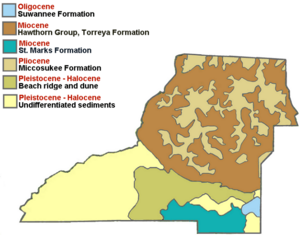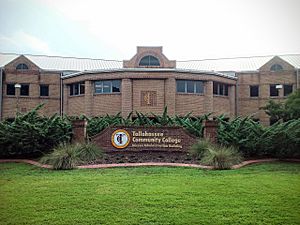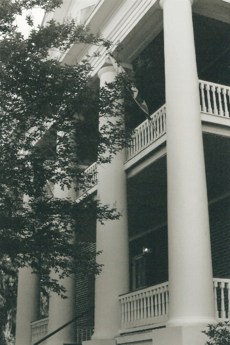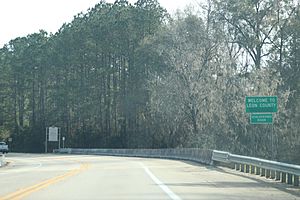Leon County, Florida facts for kids
Quick facts for kids
Leon County
|
|||
|---|---|---|---|
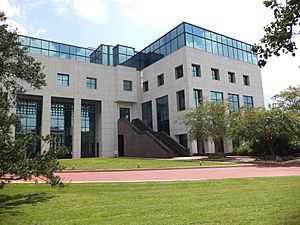
Leon County Courthouse
|
|||
|
|||
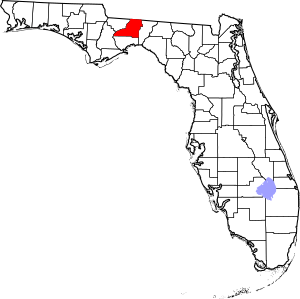
Location within the U.S. state of Florida
|
|||
 Florida's location within the U.S. |
|||
| Country | |||
| State | |||
| Founded | December 29, 1824 | ||
| Named for | Juan Ponce de León | ||
| Seat | Tallahassee | ||
| Largest city | Tallahassee | ||
| Area | |||
| • Total | 702 sq mi (1,820 km2) | ||
| • Land | 667 sq mi (1,730 km2) | ||
| • Water | 35 sq mi (90 km2) 5.0%% | ||
| Population
(2020)
|
|||
| • Total | 292,198 | ||
| • Estimate
(2023)
|
296,913 |
||
| • Density | 416.24/sq mi (160.71/km2) | ||
| Time zone | UTC−5 (Eastern) | ||
| • Summer (DST) | UTC−4 (EDT) | ||
| Congressional district | 2nd | ||
Leon County is a county located in the Panhandle part of Florida. It was named after the famous Spanish explorer, Juan Ponce de León.
As of the 2020 census, about 292,198 people lived here. The main city and county seat is Tallahassee. Tallahassee is also the state capital of Florida. Many important people, like politicians and lawyers, live and work in Tallahassee.
Leon County is part of the Tallahassee, Florida Metropolitan Statistical Area. It is home to two big public universities: Florida State University and Florida A&M University. There's also Tallahassee Community College. Together, these schools have over 70,000 students! Leon County has rolling hills, which is different from many flat parts of Florida.
Contents
- History of Leon County
- Geography of Leon County
- Population and People
- Parks and Outdoor Spaces
- Public Services
- Education in Leon County
- Fun Places to Visit
- Transportation
- Communities in Leon County
- Famous People from Leon County
- Images for kids
- See also
History of Leon County
Leon County was created in 1824. Before that, it was part of other counties like Escambia and Gadsden. It got its name from Juan Ponce de León. He was the first European to explore Florida.
In the 1830s, the United States government moved many Seminole and Creek people from this area. These Native American groups had moved south to escape settlers from Georgia and Alabama. After the Seminole Wars, many Seminole people were forced to leave. Others moved south to the Everglades.
After this, large farms called plantations grew cotton in Leon County. Enslaved people were forced to do this hard work. By the 1850s, Leon County was a big part of the "cotton kingdom" in the South. It was one of the top counties for cotton production in Florida and Georgia.
During the American Civil War, Tallahassee was a capital city for the Confederacy. But it was never captured by Union soldiers. Union forces did not enter Leon County until after the war ended.
Geography of Leon County
Leon County covers about 702 square miles. Most of this (667 square miles) is land, and 35 square miles (5.0%) is water. Unlike many flat parts of Florida, Leon County has rolling hills. This area is part of Florida's Red Hills Region. The highest point in the county is about 280 feet (85 meters) tall. It is in the northern part of the county.
Geology and Land Features
Leon County's land was formed over millions of years. It has layers of very old rocks, including basalt and sedimentary rocks. These layers were created from ancient sea life and sediments.
Over time, the Appalachian Mountains rose up. This caused more sand, silt, and clay to be carried by rivers into the area. This created new layers of sediment.
During the Ice Ages (Pleistocene epoch), the land in Leon County would sometimes be under water and sometimes emerge. This created the hills and valleys we see today.
Natural Land Areas
- Red Hills Region (in the North)
- Cody Scarp (in the central part)
- Woodville Karst Plain (in the South)
Protected Natural Areas
- Apalachicola National Forest (a part of it is in Leon County)
Lakes and Rivers
Leon County has many beautiful bodies of water:
- Lake Miccosukee
- Black Creek
- Lake Bradford
- Lake Ella
- Lake Hall
- Lake Iamonia
- Lake Jackson
- Lake Lafayette
- Lake Talquin
- Ochlockonee River
- Lake Munson
Neighboring Counties
Leon County shares borders with these counties:
- Grady County, Georgia - to the north
- Thomas County, Georgia - to the northeast
- Jefferson County - to the east
- Wakulla County - to the south
- Gadsden County - to the west
- Liberty County - to the west
Population and People
| Historical population | |||
|---|---|---|---|
| Census | Pop. | %± | |
| 1830 | 6,494 | — | |
| 1840 | 10,713 | 65.0% | |
| 1850 | 11,442 | 6.8% | |
| 1860 | 12,343 | 7.9% | |
| 1870 | 15,236 | 23.4% | |
| 1880 | 19,662 | 29.0% | |
| 1890 | 17,752 | −9.7% | |
| 1900 | 19,887 | 12.0% | |
| 1910 | 19,427 | −2.3% | |
| 1920 | 18,059 | −7.0% | |
| 1930 | 23,476 | 30.0% | |
| 1940 | 31,646 | 34.8% | |
| 1950 | 51,590 | 63.0% | |
| 1960 | 74,225 | 43.9% | |
| 1970 | 103,047 | 38.8% | |
| 1980 | 148,655 | 44.3% | |
| 1990 | 192,493 | 29.5% | |
| 2000 | 239,452 | 24.4% | |
| 2010 | 275,487 | 15.0% | |
| 2020 | 292,198 | 6.1% | |
| 2023 (est.) | 296,913 | 7.8% | |
| U.S. Decennial Census 1790-1960 1900-1990 1990-2000 2010-2019 |
|||
Who Lives in Leon County?
As of the 2020 United States census, Leon County had 292,198 people. There were 116,530 households, and 61,961 families.
In 2020, about 53.9% of the people were White (not Hispanic). About 29.9% were Black or African American (not Hispanic). About 7.8% of the population was Hispanic or Latino (of any race).
Age and Education
The median age in Leon County in 2010 was 27.8 years old. This means half the people were younger than 27.8 and half were older.
Leon County has a very high level of education. About 70.2% of its adults have some college education or a degree. This is the highest in Florida! Many people here have Bachelor's, Master's, or even Ph.D. degrees.
Parks and Outdoor Spaces
Leon County has over 1,300 acres (5.3 square kilometers) of open space. This includes forests and woodlands like the Miccosukee Canopy Road Greenway and J.R. Alford Greenway. In 2007, the county won an award for its great work in protecting and developing natural areas.
Public Services
Law Enforcement
The Leon County Sheriff's Office helps keep the peace in the county. They patrol areas outside of Tallahassee. They also protect the courts and run the county jail. The Tallahassee Fire Department and Leon County Emergency Medical Services provide fire and ambulance services.
The Tallahassee Police Department (TPD) handles policing within the city of Tallahassee. TPD was started in 1826. It is one of the oldest law enforcement agencies in the country to be officially recognized for its high standards.
Education in Leon County
Leon County is known for its excellent schools and universities.
Higher Education (Colleges and Universities)

Florida State University
Florida State University (FSU) is a large public research university. It has a big campus in Tallahassee, covering over 1,391 acres (5.6 square kilometers). In 2017, almost 42,000 students attended FSU. It is one of the oldest higher education sites in Florida, founded in 1851.
FSU is known as a "Research University with Very High Research Activity." This means it does a lot of important research. It has 16 different colleges and offers over 360 programs. FSU is home to Florida's only National Laboratory, the National High Magnetic Field Laboratory. It also runs the John & Mable Ringling Museum of Art, which is Florida's official state art museum.
FSU has many highly-ranked programs. These include law, business, engineering, medicine, film, music, and sciences. In 2019, U.S. News & World Report ranked FSU as the 26th-best public university in the country.
FSU's sports teams are called the Seminoles. They compete in NCAA Division I sports.
Florida A&M University
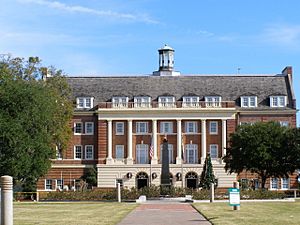
Florida A&M University (FAMU) was founded on October 3, 1887. It is a public, historically black university. FAMU's main campus has 156 buildings on 422 acres (1.7 square kilometers). In 2016, it had over 9,600 students.
FAMU offers many different degrees. These include 54 bachelor's degrees and 29 master's degrees. It also has 11 doctoral programs, including Ph.D. programs in engineering, physics, and pharmaceutical sciences. Some of its top programs are architecture, journalism, and psychology.
Tallahassee Community College
The Florida Legislature started Tallahassee State College (TSC) in 1966. It has a 270-acre (1.092 square kilometer) campus in Tallahassee.
TSC offers different types of degrees, including Associate of Arts (A.A.) degrees. In 2013, TSC was ranked first in the nation for graduating students with A.A. degrees. It is also the top school for students who want to transfer to Florida State University. As of 2015, TSC had 38,017 students.
TSC has a special program called TSC2FSU. This program guarantees that students who earn an Associate in Arts degree from TSC can get into FSU.
Other Colleges in Leon County
- Barry University School of Adult and Continuing Education – Tallahassee Campus
- Embry-Riddle Aeronautical University
- Flagler College – Tallahassee Campus
- Keiser University – Tallahassee Campus
- Lewis M. Lively Area Vocational-Technical School
- Saint Leo University – Tallahassee Campus
Primary and Secondary Education (K-12 Schools)
The Leon County School District manages all the public schools in Leon County. The district has a superintendent, five board members, and one student representative.
There are 25 elementary schools, 10 middle schools, and seven high schools. There are also special schools and charter schools.
Middle Schools in Leon County
- Cobb Middle School
- Deerlake Middle School
- Fairview Middle School
- Fort Braden School K - 8
- Governor's Charter Academy (Charter K–8)
- Griffin Middle School
- Holy Comforter Episcopal School (Private PK3–8)
- Maclay School (Private PK3–12)
- Montford Middle School
- Nims Middle School
- Raa Middle School
- Success Academy of Tallahassee
- Swift Creek Middle School
- Stars Middle School (Charter)
- School of Arts and Sciences (Charter K–8)
- Tallahassee School of Math and Science (Charter K–8)
- Trinity Catholic School (Private PK3–8)
- Cornerstone Learning Community (Private PK3–8)
High Schools in Leon County
- Amos P. Godby High School
- Atlantis Academy
- Community Christian School
- Florida A&M University Developmental Research School
- Florida State University High School
- James S. Rickards High School
- John Paul II Catholic High School
- Lawton Chiles High School
- Leon High School
- Lincoln High School
- Lively Technical Center
- Maclay School
- North Florida Christian High School
- SAIL High School
- Woodland Hall Academy
Libraries in Leon County
Leon County has a public library system called the Leroy Collins Leon County Public Library. It has 7 branches:
- Leroy Collins Main Library
- Northeast Branch Library
- Eastside Branch Library
- Dr. B.L. Perry, Jr. Branch Library
- Lake Jackson Branch Library
- Woodville Branch Library
- Jane G. Sauls Fort Braden Branch Library
The main library was renamed in 1993 to honor LeRoy Collins, who was Florida's 33rd governor.
History of Library Services
Before 1955, the Carnegie Library of Tallahassee was the only public library in the city. It was built on the FAMU campus in 1908 and served the Black community.
In 1954, a group called the Friends of the Library was formed. They wanted to create a free public library for everyone in Tallahassee. At that time, Tallahassee was the only state capital in the U.S. without a free public library.
The first Leon County free public library opened on March 21, 1956. It was located in "The Columns," one of the oldest homes in the area. To help more people get books, the Junior League of Tallahassee donated a bookmobile.
In the early 1970s, Jefferson and Wakulla Counties joined Leon County's library system. This helped expand services. Later, these counties started their own library systems. In 1991, a new, larger main library building opened. It was renamed the LeRoy Collins Leon County Public Library in 1993.
Fun Places to Visit
- Alfred B. Maclay Gardens State Park
- Apalachicola National Forest
- Birdsong Nature Center
- Bradley's Country Store Complex
- Florida State Capitol
- Florida Supreme Court
- Florida State Archives
- Florida Vietnam War Memorial
- Lake Jackson Mounds Archaeological State Park
- Leon County Fairgrounds
- Leon County's five canopy roads (roads shaded by trees)
- LeRoy Collins Leon County Public Library
- Mission San Luis de Apalachee (a historic Spanish mission site)
- Museum of Florida History
- Old Fort Park
- Tall Timbers Research Station
- Tallahassee Antique Car Museum
- Tallahassee Museum
- Tallahassee-St. Marks Historic Railroad Trail State Park
Transportation
Airports
- Tallahassee Commercial Airport
- Tallahassee International Airport
Main Roads
Major highways that go through Leon County include:
 Interstate 10
Interstate 10 U.S. Highway 27
U.S. Highway 27 U.S. Highway 90
U.S. Highway 90 U.S. Highway 319
U.S. Highway 319 State Road 20
State Road 20 State Road 61
State Road 61 State Road 155
State Road 155 State Road 263
State Road 263 State Road 267
State Road 267 State Road 363
State Road 363
Communities in Leon County
City
Census-Designated Places
These are areas that are like towns but are not officially incorporated as cities.
Other Communities
These are smaller, unincorporated communities:
- Baum
- Belair
- Black Creek
- Bloxham
- Centerville
- Chaires Crossroads
- Felkel
- Gardner
- Iamonia
- Ivan
- Lafayette
- Lutterloh
- Meridian
- Ochlockonee
- Rose
- Wadesboro
Famous People from Leon County
- Wally Amos – the person who started the "Famous Amos" chocolate chip cookie brand.
- Tony Hale – an actor, known for his role as Buster Bluth on Arrested Development.
- Jerrie Mock – an aviator and the first woman to fly around the world by herself.
- T-Pain (born Faheem Najm) – a popular hip hop and R&B singer.
- Ernest I. Thomas – one of the Marines who raised the first flag at Iwo Jima during World War II.
Images for kids
See also
 In Spanish: Condado de León (Florida) para niños
In Spanish: Condado de León (Florida) para niños




